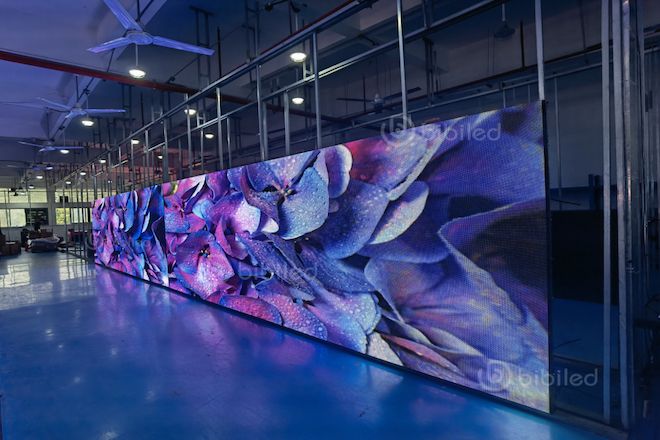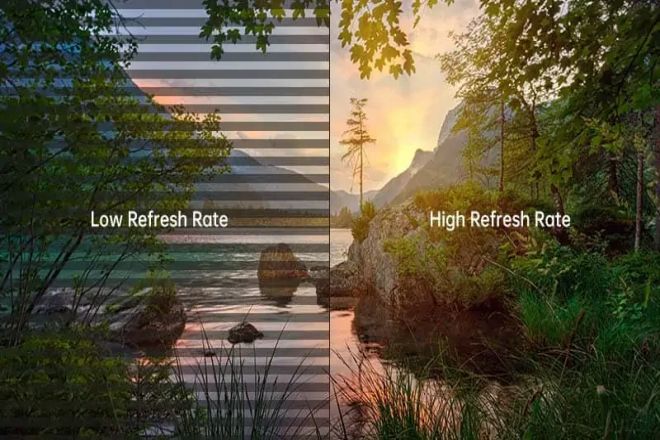Introduction

With the continuous advancement of technology and the arrival of the digital age, LED displays have become an indispensable part of our daily lives. Whether in commercial advertising, conference displays, sports events, or outdoor promotions, LED displays play an important role with their unique advantages. However, when we talk about the performance of LED displays, refresh rate and resolution are two key parameters that are often mentioned.
They not only determine the display effect of the display screen but also affect the user’s viewing experience.
1. Refresh rate of LED display

1). Refresh rate definition
The refresh rate refers to the number of times the LED display updates the display per second, which determines the smoothness and dynamic performance of the screen image.
The unit is Hertz (Hz); for example, 60Hz means the screen updates 60 times per second.
2). The role of refresh rate
A high refresh rate means faster screen updates, which can provide smoother and more natural dynamic images, especially in high-speed motion scenes.
In gaming applications, high refresh rates can significantly reduce motion blur and latency, giving players a smoother and more responsive gaming experience.
In live sports broadcasts, a high refresh rate can more accurately capture every action of the athletes, making the audience feel as if they are actually on the scene.
3). Technical implementation of refresh rate
The key to achieving a high refresh rate for an LED display lies in its drive circuit and control system.
The drive circuit is responsible for controlling the on and off of the LED lights, ensuring that each pixel can be updated at the correct moment through precise time control and synchronization technology.
The control system is responsible for receiving and processing image data, converting it into a format suitable for LED display display, and sending it to the driving circuit for display.
Advanced image processing algorithms and hardware acceleration technology can further increase the refresh rate and reduce image processing latency.
4). The relationship between refresh rate and power consumption
Although a high refresh rate can provide better dynamic image performance, it will also bring about a certain increase in power consumption.
This is because each screen update requires a certain amount of energy, and a high refresh rate means more frequent screen updates.
In order to reduce power consumption, LED display manufacturers will use a variety of technical means, such as optimizing drive circuits, reducing the power consumption of LED lights, and using energy-saving modes.
At the same time, users can adjust the refresh rate appropriately to balance the relationship between display effect and power consumption according to their own needs and usage scenarios.
2. Resolution of LED display

1). Resolution definition
Resolution refers to the number of pixels that the LED display can display, which determines the clarity and detail of the image.
It is usually expressed as the product of horizontal pixels (width) and vertical pixels (height). For example, a resolution of 1920×1080 means that the screen has 1920 horizontal pixels and 1080 vertical pixels.
2). The role of resolution
High resolution means more pixels, which can provide clearer and more detailed image quality.
In high-definition video playback, high resolution can ensure that every detail of the video picture can be accurately presented, giving the audience a more realistic visual experience.
In the field of image processing, high resolution helps to restore the original color and texture of the image more accurately, making the image more realistic and natural.
3). Technical implementation of resolution
The key to achieving high resolution in LED displays lies in the design of LED point spacing and driver IC.
The LED dot pitch refers to the distance between two adjacent LED lights. The smaller the dot pitch, the more LED lights can be placed per unit area, thereby achieving higher resolution.
The driver IC is responsible for controlling the lighting and color changes of the LED lights. Through precise driver control, it ensures that each pixel can accurately display the required color and brightness.
In addition, advanced image processing technologies and algorithms can also further improve the resolution of LED displays. For example, super-resolution technology can process low-resolution images through software algorithms to reach a higher resolution level.
4). The relationship between resolution and display area
Display area is one of the important factors affecting resolution. At the same resolution, the larger the display area, the larger the area occupied by each pixel, which may cause the image to look less detailed.
In order to expand the display area while ensuring resolution, the following methods can be used:
Use smaller LED dot spacing to place more LED lights in the same area, thereby increasing resolution.
Splicing technology is used to combine multiple LED displays to form a larger display area while keeping the resolution of each display unchanged.
Image processing technology is used to splice multiple low-resolution images into a high-resolution image and display it on a large screen. This method can make up for the problem of insufficient hardware resolution to a certain extent.
To sum up, when designing and selecting LED displays, it is necessary to balance the relationship between resolution and display area according to specific application scenarios and needs.
3. Comparison and connection between refresh rate and resolution
The difference between the two is that refresh rate and resolution play different roles in LED displays, with obvious differences in functions and application scenarios.
1). Functional differences
The refresh rate mainly focuses on the number of times the screen updates the display per second, which determines the smoothness and dynamic performance of the image, while the resolution focuses on the number of pixels that the screen can display, which determines the clarity and dynamic performance of the image. Delicacy.
2). Differences in application scenarios
- Refresh rate:
In scenes that require a fast dynamic display, such as live sports broadcasts, games, etc., a high refresh rate can provide smoother and more natural dynamic images and reduce motion blur and delay.
- Resolution:
In scenarios where high-definition images need to be displayed, such as high-definition video playback, image processing, etc., high resolution can provide clearer and more delicate image quality, allowing the audience to see more details and pictures.
For example, in e-sports competitions, players pay more attention to the refresh rate of the screen because a high refresh rate can ensure the smoothness and response speed of the game screen, while in movie theaters or high-end conferences, audiences pay more attention to the resolution of the screen because high refresh rates Resolution can bring a more realistic visual experience.
3). The connection between the two
Although refresh rate and resolution are different in functions and application scenarios, they have a common role in improving the performance of LED displays.
- Working together:
The combination of a high refresh rate and high resolution can bring users a better visual experience. The high refresh rate ensures the smoothness and dynamic performance of the image, while the high resolution provides a clearer and more detailed image quality.
The combined effect of the two enables the LED display to achieve excellent performance in terms of fast dynamic display and high-definition image quality display.
- Achieve high resolution while meeting a high refresh rate:
When designing and producing LED displays, manufacturers need to comprehensively consider the requirements of refresh rate and resolution. By optimizing the drive circuit, control system, and image processing technology, high resolution can be achieved while ensuring a high refresh rate.
For example, the use of advanced driver ICs and image processing algorithms can improve the refresh speed and display effect of pixels; the resolution level can be improved by reducing the LED dot spacing and increasing the pixel density.
In addition, reasonable display area planning and splicing technology can also expand the display area while maintaining high-resolution levels.
4. How to choose the right LED display

1). Choose according to the application scenario
- Advertising display:
For advertising display, since the advertising content is mostly static or slowly changing images and text, the refresh rate requirement is relatively low, but the resolution requirement is high to ensure the clarity and attractiveness of the advertising content. It is recommended that an LED display with a refresh rate above 60Hz and high resolution be chosen.
- Conference presentation:
In conferences and presentations, the content to be displayed may include PPTs, videos, pictures, etc., so the refresh rate and resolution need to reach a certain level. It is recommended that an LED display with a refresh rate above 120Hz and a resolution sufficient to meet content display needs be chosen.
- Sports live broadcast:
Sports live broadcast needs to display the athletes’ actions and competition process quickly and smoothly, so it has high requirements for refresh rate. It is recommended that an LED display with a refresh rate of 120Hz or above be chosen, and the resolution should also be selected based on the content quality of the playback source.
- Exhibitions and performances:
On these occasions, high-definition, high-quality images, and videos need to be displayed, so the resolution and refresh rate needs to reach a high level. It is recommended to choose an LED display with high resolution (such as 4K or higher) and high refresh rate (such as 144Hz or higher).
2). Consider cost-effectiveness
The prices of LED displays with different combinations of refresh rates and resolutions vary greatly. When choosing, you need to weigh it based on your budget and actual needs. Generally speaking, LED displays with high refresh rates and high resolutions are more expensive but can provide a better visual experience.
If the budget is limited, you can reduce the requirements appropriately according to actual needs and choose products with higher cost performance.
3). Technology development trends
With the continuous advancement of technology, LED displays will have greater improvements in refresh rate and resolution.
In the future, LED displays with higher refresh rates (such as 240Hz, 360Hz) and higher resolutions (such as 8K, 16K) will become the mainstream of the market. This will further meet people’s needs for high-definition and smooth visual experiences.
Market competition will also become more intense. Major LED display manufacturers will continue to launch new technologies and new products to seize market share.
Therefore, when choosing an LED display, in addition to paying attention to the performance and quality of the product, you also need to pay attention to the manufacturer’s technical strength and market reputation.
Conclusion
To sum up, refresh rate and resolution are two indispensable key parameters in LED display performance evaluation. The refresh rate determines the dynamic image performance of the display, while the resolution determines the clarity and detail of the image. When choosing an LED display, we need to comprehensively consider these two parameters based on specific application scenarios and budget.
Finally, if you want to know more about LED displays, please get in touch with us.
